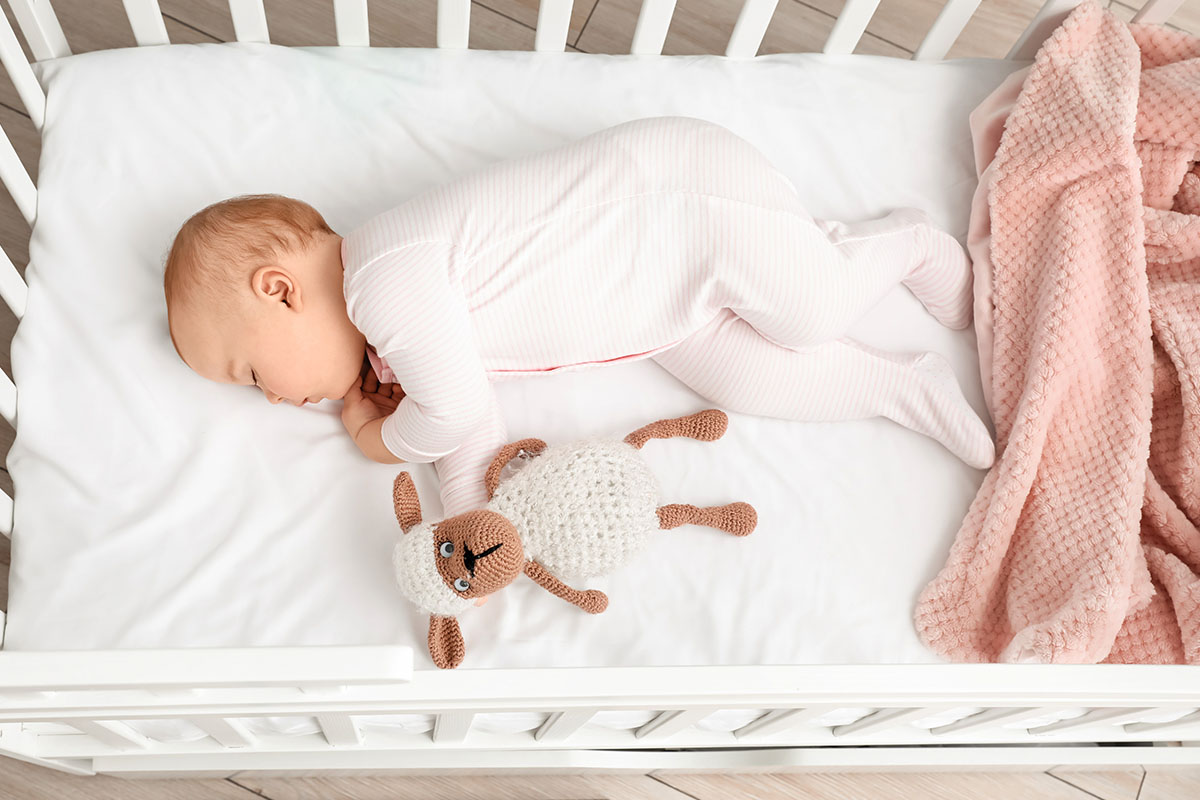Table of Contents
 The pediatric community has made considerable strides in reducing deaths from Sudden Infant Death Syndrome (SIDS) over the last 30 years. Sleep-related deaths are declining because of educational campaigns about the safest ways for babies to sleep. However, according to the American Academy of Pediatrics, around 3,500 infants die from sleep-related deaths each year. How and where your baby sleeps can make a difference in their safety. There’s room for families to make choices that work best, but there are some essential guidelines that can help parents create a safe sleep environment.
The pediatric community has made considerable strides in reducing deaths from Sudden Infant Death Syndrome (SIDS) over the last 30 years. Sleep-related deaths are declining because of educational campaigns about the safest ways for babies to sleep. However, according to the American Academy of Pediatrics, around 3,500 infants die from sleep-related deaths each year. How and where your baby sleeps can make a difference in their safety. There’s room for families to make choices that work best, but there are some essential guidelines that can help parents create a safe sleep environment.
Is It Okay for My Baby to Sleep in My Bed?
Many parents want their infants close to them during the night in the early months. Having your infant nearby helps with late night and early morning wakings and feedings and reduces the risk of SIDS. However, there’s a difference between co-sleeping and sharing a bed with your baby. The AAP recommends sleeping with your baby in your room but not sharing the same bed for the first six months. Research shows that the risk of SIDS death increases five times when an infant under three months of age shares a bed with a parent. The risk is three times higher for babies between 3 months and a year old. The best solution for babies six months and younger is a separate bassinet or crib in the same room with their parents.
How Can I Keep My Infant Safe While They Sleep?
The first months of parenting a newborn can be exhausting and nerve-wracking. Fortunately, the AAP offers excellent guidelines for keeping baby safe while sleeping:
- Infants should sleep on their backs without soft toys, pillows or blankets.
- Put your baby to sleep on a firm, flat, non-inclined surface. Use a crib or bassinet that meets federal safety standards.
- Monitor your baby while in strollers, car seats or swings, especially if they are younger than four months. These should not be their primary place to sleep and should not be a replacement for their crib or bassinet.
- Breastfeeding reduces the risk of sleep-related death. Choose breastfeeding for the baby’s first six months when possible.
- Parents should avoid nicotine, alcohol, marijuana, opioids and illicit drug use.
- Make sure your baby receives routine immunizations.
- Pacifier use is associated with reducing the risk of SIDS. Talk with your pediatrician about introducing a pacifier.
- Avoid commercial devices like cardiorespiratory monitors that claim to reduce risk. AAP says there is no evidence that these devices reduce risk.
- Supervised “tummy time” while your baby is awake helps with infant development and reduces the risk of positional plagiocephaly (a condition where an infant’s head becomes flattened from too much time on their back).
- If you swaddle your infant, make sure they are on their back. Don’t use weighted clothing or swaddles, and stop swaddling when your infant shows signs of attempting to roll (usually at 3 or 4 months).
How Should I Monitor My Baby?
The best approach is to keep your baby in your room on a separate surface for the first six months. After six months, moving your baby into their own room depends on your preferences. For some families, a separate nursery can mean better sleep for both parents and child. Remember that consistency is key: when you decide to move your baby, stick with it, even if the initial transition is challenging. Many parents have questions about the best way to monitor babies. Here are a few tips:
- The AAP doesn’t recommend so-called smart baby monitors. These wearable devices monitor a baby’s heart rate and breathing and alert parents if something goes wrong. However, faulty equipment can lead to false alarms and unnecessary trips to the ER. These monitors can also create a false sense of security. Finally, some “smart” monitors have been recalled because sensor pads can become wrapped around babies’ necks and cause strangulation.
- Video monitoring is popular and safe overall. Some parents worry about hacking when video monitoring uses internet technology. However, wired video monitors can be essential for working parents away from their babies during the day.
- Many families still prefer an old-school audio monitor that lets parents know when their baby is awake. It alerts us when a baby is in distress while helping us avoid overreaction. Ninety percent of SIDS cases happen in babies younger than six months. So after that threshold, letting your baby sleep in their own room with an audio monitor is very safe.
Sleep Safety and Your Baby: Your Pediatrician Is Your Partner
Parenting a newborn is an exciting and exhausting time. Parents and babies need sleep for good health. But there’s so much to worry about. Keeping your infant in your room on a separate sleep surface for six months is a pediatrician-recommended approach to preventing SIDS. However, when monitoring your baby, sometimes less is more. So-called smart monitors with wires and sensors marketed to anxious parents often do more harm than good. New parents often think more technology is better, but that’s not always the case. Your pediatrician is an excellent resource if you have questions about sleep safety and baby monitors. At Loudoun Pediatric Associates, our team of caring providers has guided thousands of new parents through the process. We keep babies’ safety and parents’ peace of mind front and center as you navigate this joyful (and sometimes stressful) new territory.







